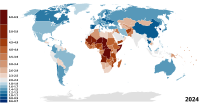
Photo from wikipedia
Background: While most countries have experienced reductions in the total fertility rate (TFR), there are countries where the fertility transition has not begun and others where the fertility transition has… Click to show full abstract
Background: While most countries have experienced reductions in the total fertility rate (TFR), there are countries where the fertility transition has not begun and others where the fertility transition has stalled with TFR still well above replacement level. We use these contexts of “fertility stagnation” to explore reasons behind contraceptive non-use among women who desire to delay or avoid a future birth. Specifically, we explore whether women’s reasons for not using contraception are stagnant as the population-level indicator, TFR, suggests or are more dynamic. This nuanced understanding can inform programmatic direction for countries especially in need. Methods: Using Demographic and Health Survey (DHS) data from the two most recent surveys of ten study countries—five countries that have not yet experienced a fertility transition (“pre-transitional”) and five countries that began the fertility transition but stalled (“transitional”)—we explore trends in reasons for non-use. Results: We find that that reasons for non-use are changing. Specifically, in pre-transition study countries, women are increasingly citing attitudes opposing contraception as reasons for non-use. In transition countries, women are increasingly citing reasons related to service quality and method side effects. Perceived low fecundability is increasingly cited among both pre-transition and transition study countries. Geographical access and cost are not prominent frequently cited at either time point. Conclusions: These findings highlight the need for prioritized programmatic attention aimed at: reducing opposition to contraception in pre-transitional countries; improving service quality and addressing issues of side-effects, both experienced and perceived, in transitional countries; and addressing fecundability perceptions in both types of country contexts. We remind policy makers that even in contexts of fertility stagnation, underlying attitudes, norms, and barriers to contraceptive uptake are shifting. Lack of change at the population-level can mask important changes at the individual-level that must be accounted for in program development and implementation.
Journal Title: Gates Open Research
Year Published: 2019
Link to full text (if available)
Share on Social Media: Sign Up to like & get
recommendations!